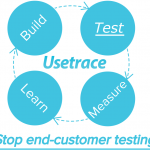Loved by many for its easy-to-use UI and codeless extension to Selenium, the Selenium IDE is finally arriving at end of its road. After Firefox updated to version 55, the Selenium IDE has completely stopped working because the support for legacy extensions was dropped. The issue has already been covered extensively by SeleniumHQ and Quora.
So what steps should you take to ensure that your digital business won’t lose revenue due to a broken website? There are two main alternatives you could choose from if you want to avoid cumbersome manual testing.
1. Learn Selenium or a Selenium framework
Selenium and Selenium-based frameworks are used to write scripts that test your web app. However, writing tests manually is slow and they become obsolete quickly when your agile team changes the website all the time to keep up with changing customer demands.
Learning how to proficiently use Selenium might take you or someone from your team weeks or months, which only emphasizes the hidden costs of learning something new and complex.
In addition, scripting tests usually requires investment in testing infrastructure which might rake the hidden costs up to thousands of dollars. Luckily, there is an option number 2, which lets you avoid hiring anyone extra, learning how to write scripts, maintaining tests that deprecate, and investing in infrastructure.
2. Codeless test automation with Usetrace
Agile development and testing teams have already found codeless testing tools such as Usetrace. Usetrace offers all the functionalities Selenium IDE had and more. Usetrace harnesses its power from Selenium and combines it with a beautiful and easy-to-use UI that lets you create and run tests visually without code. Test visualization helps you easily track how your tests are progressing, helping you find bugs much quicker than with traditional methods. Even dynamic content tests effortlessly.
Traces you’ve created can be scheduled and ran automatically, boosting deployment testing speeds by up to 150%. It even integrates with your favorite continuous integration tools such as Slack, Jira and Jenkins removing even more manual tasks.
Usetrace let’s you create modules/patterns from existing traces to rapidly create larger test suites. Traces can keep up with your quickly changing website enabling agile developer teams to do what they do best.
Usetrace was built for collaboration, enabled by cloud infrastructure. You can effortlessly invite team members to share the testing responsibility while keeping everyone up to date. Test reporting has never been easier.
Running in the cloud also enables you to execute several tests simultaneously so that you don’t have to spend time waiting for tests to finish. For faster testing, you can always scale your setup as much as you need.
A feature that always gets our customers excited is the ability to use random generated data so that your form related tests actually work when running automated tests. Claim your limited time offer here and discover more features that help you focus on what’s important.



